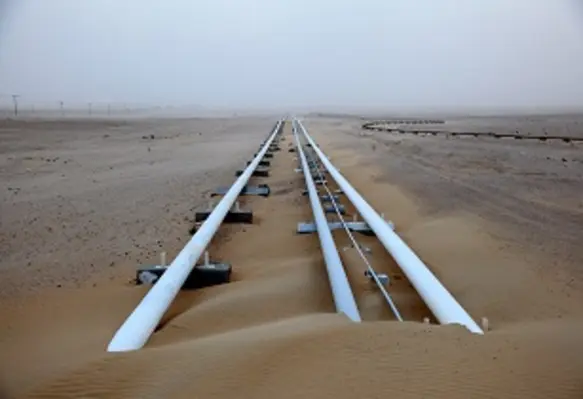A GPT Industries webinar hosted by Oil Review Middle East discussed the weak links in monolithic isolations joints (MIJs) and how the company has addressed them
Material, weld and equipment failures along with internal and external corrosion around pipe connections are a major cause of pipeline failure.
In a webinar entitled ‘Pipeline corrosion prevention: eliminating the weak link’, Alex Grimmer, product manager at GPT Industries, discussed the role of monolithic isolation joints (MIJs) and their role in corrosion prevention, explaining how GPT has improved the design of MIJs, as well as the manufacturing and testing processes, to ensure joint integrity and performance. The company’s Electrostop MIJ are specially engineered to eliminate dangerous leaks and corrosion and permanently seal pipeline connections.
Grimmer explained that a Chevron paper issued in 2014 had highlighted weak points in MIjs and the manufacturing process. These include the risk of chemical attack on nitrile seals, hard weld heat affected zones, issues with forging and pipe traceability, weaknesses in the isolation material, common design issues, and permeability and temperature thresholds.
“We went through these findings systematically, improving MIJ design and material section, material traceability, test integrity and inspection processes, to ensure that every MIJ that leaves our facility is made properly to isolate and withstand the conditions of the pipeline it’s going to be welded into,” said Grimmer.
Addressing the challenges
GPT upgraded the o-rings to a viton material which could withstand a higher temperature threshold as well as offering exceptional chemical compatibility. Grimmer noted the high temperatures the joint could be exposed to both during the manufacturing process and during its life in the pipeline, which had been highlighted in the Chevron paper and had caused competitor products to become damaged and unseated.
“While we can control the temperature in the manufacturing process, there can be unexpected temperatures surges, so it is important to have safety factors in those materials and their capabilities to cope with the production process and applications post-installation,” he commented. “The design life expectations for MIJs can be 20-30 years or longer; the joint is going to be welded into a pipeline system, buried and forgotten – so it’s important to plan for the worst case scenario.”
With regard to the isolating material, Grimmer noted the importance of controlling the weld heat during the manufacturing process. One of the flaws of GRE materials is that they can be permeable, so the company is working with GRE sheet producers to eliminate this as far as possible.
Grimmer stressed the importance of testing every MIJ individually from start to finish to ensure integrity. “With an MIJ there are so many variables that can occur during the production process; it doesn’t mean every joint is created equal. So every single part has to be tested to make sure it properly isolates and properly seals, and can withstand pipeline conditions,” he said. We’ll hydrostatically test and pneumatically test every joint that’s produced in our facility.”
Grimmer pointed out that controlling temperature during welding is essential for successful MIJ production, and that every weld has to be inspected.
Grimmer discussed the role of coatings, both internal and external, in improving the integrity of the MIJ and adding durability and longevity to the joint. The proper selection of the internal coating is critical to avoid comprising the ability to isolate the electrical current and prevent damage to the internal components. If the pipeline is running above ground, a topcoat should be added, polyurethane being ideal for long-term durability.
He stressed that coatings were only as good as their application. “The simplest failure at the surface preparation step can lead to coating disbondment or failure to adhere to the substrate.”
Grimmer highlighted the importance of material and product traceability and providing test records, which the Chevron paper had highlighted as a common pitfall for manufacturers.
“Lack of traceability in steel components is a major risk... if you don’t have any test reports or material traceability, that part is basically worthless. It can’t go into the pipeline with confidence. Traceability and test reports ensure not only that the joint is made properly, but that you can prove with the paperwork.” Essential traceability reports are Steel MTR, hydrotest reports, coating inspection reports and weld inspection reports.
Finally, Grimmer said that while the ElectroStop MIJ, which is designed and built in the USA, has been very successful, it has faced shipping and production cost challenges in these uncertain times. The company has therefore partnered to make a more accessible MIJ in terms of price and leadtime, based on the same quality system that it has been developing over the last seven to eight years.
Available to customers across the globe, the ElectroSeal is based on the proven u-seal design and two-part epoxy system, and is available in a full range of pressure classes, produced with material traceability and all relevant test reports.
“We’ve been working to bring this product to market for the last couple of years, and are starting to see acceptance grow. We’re going to work to grow awareness of this product, and continue to try to add value for you and your partners,” Grimmer concluded.
The presentation was followed by a lively Q&A session, when Grimmer was joined by Rony Roy, senior applications engineer at GPT Industries.
To watch the webinar, go to https://www.oilreviewmiddleeast.com/webinar/pipeline-corrosion-prevention-eliminating-the-weak-link
For further information see the website at www.gptindustries.com









